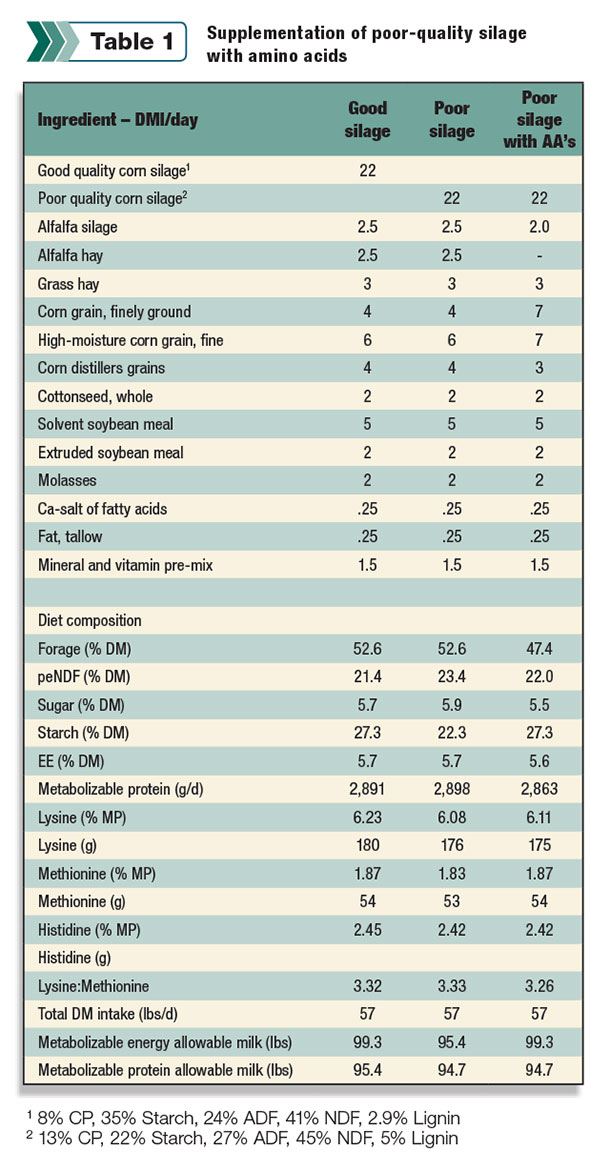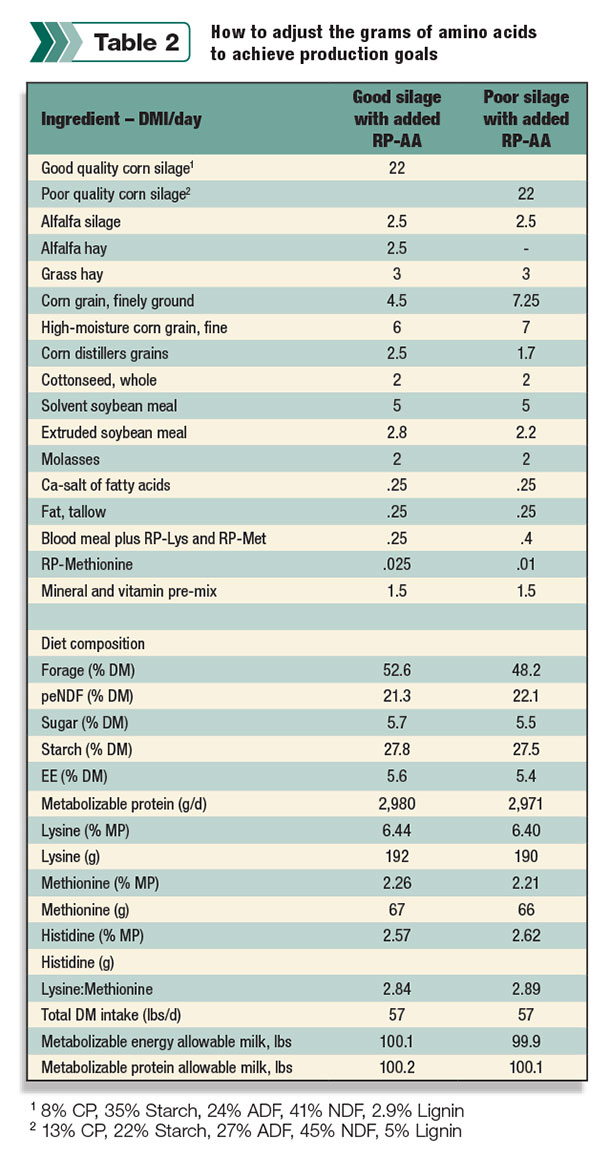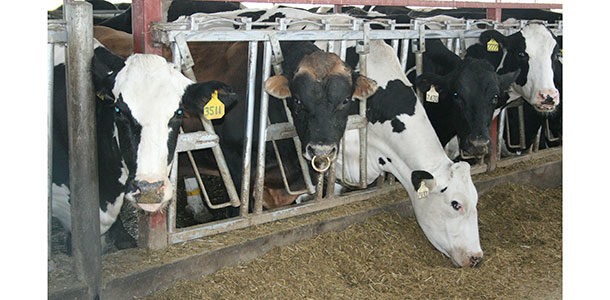In the recent past, distinct differences existed in the composition of diets fed to high-producing dairy cows in different parts of the U.S. and Canada. Forage availability often dictated how the rations were formulated. Several factors dictated the main forages available, including weather and soil quality. The Northeast relied heavily on corn silage with some winter grass hay/silage; the Midwest, alfalfa silage with some corn silage and limited alfalfa hay; the West and Southwest, alfalfa hay and corn/sorghum silage.
Typically, diets were formulated to around 18 percent crude protein. The concentrate consisted of corn grain, sorghum grain, roasted soybean, soybean meal and cottonseed or canola meal, depending on regional availability. On the West Coast, many byproducts were used.
The types and levels of forages have changed with improvements in corn and sorghum hybrids. New crop management technologies have changed how rations are balanced. Today’s corn and sorghum silages, with their high yield and digestibility, make it more attractive for producers to crop them and for nutritionists to include them in the diets.
The end result has been a convergence on the forage makeup of the basal diet, removing large differences that once existed around the country.
With the more generalized use of corn silage, the fine-tuning of a diet’s nutrient supply is less dependent on the forage base and more dependent on the forage quality. Ideally, a large percentage of the consumed silage should be fermented and used by the rumen micro-organisms. The objective is to maximize volatile fatty acid (VFA) production and ruminal microbial protein synthesis from forage.
The advent of software models to balance dairy rations, e.g., NRC and CNCPS, has opened the gates for refining the nutritional quality of the diet. Nutritionists can design diets using least-cost balancing features that significantly impact the concentrate feeds used to meet the cow’s nutrient requirements.
Still, subtle differences remain with how the diets are fine-tuned. The feed ingredients used depend on their individual prices as well as milk component prices. Component pricing is important to producers in regions with Federal Milk Marketing Orders (FMMO) where milk is paid for based on the pounds of protein and fat delivered.
Energy first; amino acids second
New corn hybrids yield a higher level of dry matter (DM) per acre, have high fiber digestibility and contribute an important amount of starch to the basal diet.
For example, if a cow consumes 57 pounds of DM in a 52 percent forage-based diet, then 22 pounds of good-quality corn silage could provide more than 7 pounds of starch to the rumen. The majority of this starch would be used by rumen micro-organisms to produce VFAs and microbial mass.
However, if the forage was grown under stressful conditions, e.g., heat stress, or crop management and silage preservation were far from ideal, the energy and protein resulting from the rumen fermentation may suffer due to lower levels of starch-filled grains, lower fiber digestibility or forage nutrient losses during storage.
When silage quality is far from ideal, nutritionists need to re-adjust the concentrate portion of the diet to make sure the diet supplies all the required nutrients to support high production and good health and reproduction.
As an example, a diet was simulated by the nutrition program CNCPS V6. The corn silage quality (DM, CP, neutral-detergent fiber, acid-detergent fiber, lignin and starch) was varied to mimic a good-quality and a poor-quality corn silage ( Table 1 ).

Poor-quality corn silages have less starch, higher NDF, lignin and CP than good-quality corn silage. Therefore, adjustments must be made to make up for the lower nutrient supply.
The good-quality corn silage diet was balanced to produce 100 pounds of 3.6 percent fat and 3.1 percent protein milk. When the corn silage quality changed to poor, the nutritive value of the TMR changed, causing an estimated 4-pound loss in metabolizable energy allowable milk. It also produced a 1-pound loss in metabolizable protein allowable milk – more on this later.
With the increased use of corn silage in the diet, the first issue to consider is energy. A good-quality, highly digestible corn silage provides a great deal of starch and, indirectly, excellent-quality protein in the form of microbial mass.
Despite a poor-quality corn silage being higher in crude protein percentage, its quality is not as good in terms of amino acid supply. Further, the lower starch and fiber digestibility significantly reduces the rumen’s fermentation output.
The difference in rations is about energy, and to correct the deficiency more starch and better-quality rumen-undegradable protein are required to maintain the same diet’s nutrient profile. When poor corn silages are used, besides affecting the rumen function dynamics, the diet may cost more due to the concentrates needed to keep similar energy and amino acid profile flows.
The lysine-to-methionine ratio
From an amino acid point of view, the underlying issue is the less-than-optimal lysine-to-methionine (Lys-Met) ratio. Cows need grams of amino acids to maximize milk production and to support their metabolic needs for good health and reproduction.
However, lysine and methionine need to be at a fixed ratio if the goal is to optimize milk component output. Independent of the corn silage quality, the diet’s Lys-Met ratio is almost always higher than ideal. This high ratio is expensive. Not only will the cow not be able to use the excess lysine, excess nitrogen is excreted into the environment.
To resolve this issue, dietary changes can be made to lower the grams of lysine in the metabolizable protein or to increase the grams of methionine to obtain the ideal Lys-Met ratio, which for the CNCPS V6 model is 2.85-to-1. Lowering the grams of lysine fed is not advisable.
Lysine is an essential amino acid that has a direct impact on milk volume. Increasing the grams of methionine is more desirable. The cow will benefit from the extra supply of the two most limiting amino acids for milk protein production and can maximize the total diet’s nitrogen utilization efficiency.
Supplemental amino acids
Despite the changes introduced in the diet with poor corn silage, the total grams of lysine in the metabolizable protein were only reduced by 4 grams and the methionine by 1 gram. Nevertheless, when fine-tuning rations for amino acids, a few grams can make a big difference in realizing the cow’s genetic potential.
This last step is the most critical since it is not a matter of adding a fixed amount of grams of a rumen-protected amino acid as a top-dress. Although most diets fed to lactating cows in North America have a high Lys-Met ratio, and cows may benefit from simply adding a commercial rumen-protected methionine source, these products are an investment and need to be used wisely.
Nutrition software programs should be used to adjust the grams included in the diet. As an example, from the diets shown previously, we can use the model’s output to simply add enough grams of a commercial rumen-protected methionine to reach the optimal Lys-Met ratio, or we can add extra grams of lysine and methionine to optimize the milk protein output ( Table 2 ).

Over the last few years, the tendency has been to increase the corn silage inclusion rate of diets fed to lactating cattle. From a forage point of view, diets no longer vary much among regions of the country.
The quality of corn silage has a marked influence on the total flow of good-quality amino acids in the metabolizable protein, and it is more about rumen-available energy than the crude protein or amino acid profile of the silage.
On the other hand, when fine-tuning the amino acids of the metabolizable protein, the amino acid profile of the rumen-undegradable protein in the concentrates makes a difference.
When good-quality corn silage is available, fewer amino acids from a concentrate’s rumen-undegradable protein are needed. Therefore, more room exists to include byproducts (i.e., corn distillers grains) with a poor amino acid profile.
However, when corn silage is of poor quality, less metabolizable protein will flow out of the rumen and concentrates with better amino acid profiles must be included in the diet. When aiming at maximizing milk production and composition along with cow health and reproduction, the addition of rumen-protected amino acids sources is warranted.
Their inclusion must be practiced with the aid of software models that offer features to estimate each amino acid supplied in order to reach the desired grams to optimize the diet’s nutrient output. PD
Daniel Luchini, Ph.D., is the manager of ruminant product technical services for Adisseo, has a Ph.D. in dairy science from the University of Wisconsin and has received seven U.S. patents.

Dan Luchini
Ruminant Product Technical Services
Adisseo







